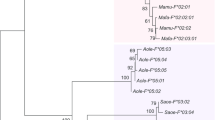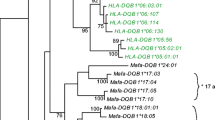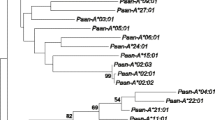Abstract
The human Rh blood group locus consists of two structurally related genes (D and CcEe) in Rh-positive haplotypes but a single gene (CcEe) in Rh-negative haplotypes. The genome of rhesus monkeys (Macaca mulatta), while not expressing any of the human Rh D, C, c, E, or e specificities, carries a Rh-like locus strongly related to the human Rh locus. Southern blot analysis suggested the presence of only one Rh-like gene with an additional truncated fragment corresponding to the 5′ region. RNA preparations from M. mulatta bone marrow cells contained Rh-like species of 1.7 kb. Two allelic Rh-like transcripts were amplified by PCR and sequenced. The predicted translation product of the first transcript was a 417-amino-acid protein closely similar to the human Rh counterpart. The predicted product of the second transcript consisted of a 361-amino-acid polypeptide truncated in the NH2 terminal region and differing from the former by a few substitutions. The macaque Rh-like protein sequences differed from those of human D and Cc/Ee polypeptides by 22–25%, whereas the degree of identity between the human proteins was 91.5%. Implications of these results in the analysis of the evolutionary pathway of the Rh locus are discussed.
Similar content being viewed by others
References
Agre P, Cartron JP (1991) Molecular biology of Rh antigens. Blood 78:551–563
Avent ND, Ridgwell K, Tanner MJA, Tanner DJ (1990) cDNA cloning of a 30 kDa erythrocyte membrane protein associated with Rh (Rhesus)-blood-group-antigen expression. Biochem J 271:821–825
Chérif-Zahar B, Bloy C, Le Van Kim C, Blanchard D, Bailly P, Hermand P, Salmon C, Cartron JP, Colin Y (1990) Molecular cloning and protein structure of a human blood group Rh polypeptide. Proc Natl Acad Sci USA 87:6243–6247
Chérif-Zahar B, Mattéi MG, Le Van Kim C, Bailly P, Cartron JP, Colin Y (1991) Localization of the human Rh blood group gene structure to chromosome 1p34.3–1p36.1 region by in situ hybridization. Hum Genet 86:398–400
Chérif-Zahar B, Le Van Kim C, Rouillac C, Raynal V, Cartron JPC, Colin Y (1993) Organization of the gene encoding the human blood group RhCcEe antigens and characterization of the promoter region. Genomics (in press)
Colin Y, Le Van Kim C, Tsapis A, Clerget M, d'Auriol L, London J, Galibert F, Cartron JP (1989) Human erythrocyte glycophorin C. J Biol Chem 264:3773–3780
Colin Y, Chérif-Zahar B, Le Van Kim C, Raynal V, Van Huffel V, Cartron JP (1991) Genetic basis of the RhD-positive and RhD-negative blood group polymorphism. Blood 78:2747–2752
Engelman DM, Steitz TA, Goldman A (1986) Identifying nonpolar transbilayer helices in amino acid sequences of membrane proteins. Ann Rev Biophys Biophys Chem 15:321–353
Fisher RA, cited in Race RR (1944) An “incomplete” antibody in human serum. Nature 153:771–772
Green FA (1966) Sulfhydryl reagents and Rh activity of erythrocyte stroma. Nature 211:852
Hermand P, Mouro I, Huet M, Bloy C, Suyama K, Goldstein J, Cartron JP, Bailly P (1993) Immunochemical characterization of Rh proteins with antibodies raised against synthetic peptides. Blood (in press)
Issitt PD (1989) The Rh blood group system, 1988: eight new antigens in nine years and some observations on the biochemistry and genetics of the system. Transf Med Rev 3:1–12
Kozak M (1986) Bifunctional messenger RNAs in eukaryotes. Cell 47:481–483
Landsteiner K, Wiener AS (1940) An agglutinable factor in human blood recognized by immune sera for Rhesus blood. Proc Soc Exp Biol Med 43:223
Levine P, Celano M, Fenichel R, Pollack W, Singher H (1961) A ‘D-like’ antigen in Rhesus monkey, human Rh positive and human Rh negative red blood cells. J Immunol 87:747–752
Levine P, Cellano MJ, Wallace J, Sanger R (1963) A human “D-like” antibody. Nature 198:596–597
Levine P, Stetson RE (1939) An unusual case of intragroup agglutination. JAMA 113:126–127
Levine P, Burnham L, Katzin EM, Vogel P (1941a) The role of iso-immunization in the pathogenesis of erythroblastosis fetalis. Am J Obstet Gynecol 42:925–937
Levine P, Katzin EM, Burnham L (1941b) Isoimmunization in pregnancy, its possible bearing on the etiology of erythroblastosis fetalis. JAMA 116:825–827
Le Van Kim C, Mouro I, Chérif-Zahar B, Raynal V, Cherrier C, Cartron JP, Colin Y (1992) Molecular cloning and primary structure of the human blood group RhD polypeptide. Proc Natl Acad Sci USA 89:10925–10929
Moor Jankowski J, Wiener AS (1972) Red cell antigens of primates. In: Pathology of Simian primates part I. Karger, Basel, pp 270–317
Moureau P (1941) Recherches sur un nouvel hémo-agglutinogène du sang humain. Acta biol Belgica 1:123
Petz LD, Garratty G (1980) Acquired immune hemolytic anemia. New York, Churchill Livingstone
Race RR, Sanger R (1975) Blood groups in man, 6th ed. Oxford, Blackwell, pp 178–260
Saboori A, Denker BM, Agre P (1989) Isolation of proteins related to the Rh polypeptides from non-human erythrocytes. J Clin Invest 83:187–191
Saiki RK, Gelfand DH, Stoffel S, Scharf SJ, Higuchi R, Horn GT, Mullis KB, Erlich HA (1988) Primer-directed enzymatic amplification of DNA with a thermostable DNA polymerase. Science 239:487–491
Sambrook J, Fritsch EF, Maniatis T (1989) Molecular cloning, 2nd ed. Cold Spring Harbor Laboratory Press, Cold Spring Harbor, NY
Sanger F, Nicklen S, Coulson AR (1977) DNA sequencing with chain terminating inhibitors. Proc Natl Acad Sci USA 74: 5463–5467
Shaw MA (1986) Monoclonal antibodies anti-LWab and anti-D reagents recognize a number of different epitopes. J Immunogenet 13:377–386
Socha WW, Ruffié J (1983) Blood groups of primates: theory, practice and evolutionary meaning. Alan R Liss Inc, New York, pp 75–90
Socha WW, Ruffié J (1990) Monoclonal antibodies directed against human red cell antigens in tests with the red cells on nonhuman primates. Rev Fr Transfus Hémobiol 33:39–48
Socha WW, Moor Jankowski J (1980) Chimpanzee R-C-E-F blood group system: a counterpart of the Rh-Hr blood groups. Folia Primatol (Basel) 33:172–188
Wiener AS (1944) The Rh series of allelic genes. Science 100: 595–597
Wiener AS, Moor Jankowski J, Gordon EB (1964) Blood groups of apes and monkeys. IV. The Rh-Hr blood types of anthropoid apes. Am J Hum Genet 16:246–253
Author information
Authors and Affiliations
Rights and permissions
About this article
Cite this article
Mouro, I., Le Van Kim, C., Cherif-Zahar, B. et al. Molecular characterization of the rh-like locus and gene transcripts from the rhesus monkey (Macaca mulatta). J Mol Evol 38, 169–176 (1994). https://doi.org/10.1007/BF00166163
Received:
Accepted:
Issue Date:
DOI: https://doi.org/10.1007/BF00166163




